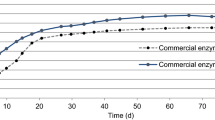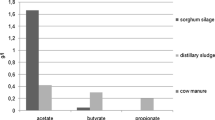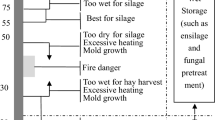Abstract
Maize silage (Atletico, FAO 280) is being anaerobically fermented with cow manure (45 °C, pH 7.1, hydraulic retention time 67 days) in a commercial scale (8,210 MWh electric power and 8,700 MWh heat power per year). The fermentation residues are being mechanically separated into the liquid fraction and the solid pulp (0.9 % hemicelluloses, 8.4 % cellulose, 5.7 % lignin). The solid pulp is being predryed and subsequently pyrolyzed. The pyrolysis takes place in the newly developed horizontal continuous pyrolysis reactor. The technology is run by the hot flue gases (410 ± 11 °C) from the biogas combustion engine (383 m3 of biogas per hour). The carbon powder obtained is being technologically and economically analyzed as a solid biofuel instead of biochar. The results obtained by standardized methods show that the new variety of products obtained outperforms many of the conventional solid biofuels not only in technological and environmental indicators, but also from the economical point of view.
Similar content being viewed by others
Explore related subjects
Discover the latest articles, news and stories from top researchers in related subjects.Avoid common mistakes on your manuscript.
Introduction
Biochar is a carbon powder obtained by pyrolysis of lignocellulose at the absence of air, respectively, oxygen. Due to its high porosity, it used to be a traditional improver of soil fertility, however, its current prices make this old practice difficult. Notable effort to reduce the cost was published recently (Maroušek 2014). The novelty is based on processing of waste phytomass (instead of costly wood) and waste energy (instead of utilization of the energy obtained from the lignocellulose itself). In addition, it was proved that if the waste material was previously subjected to anaerobic fermentation, the microporosity (quality) is higher due to the removal of fermentable parts of the organic matter. Despite all the positive environmental aspects (Bare 2014; Garmestani 2014), the tradition of biochar application survived only in the rural parts of East Asia and Africa. Therefore, it is not surprising that the initial market analysis supported by the study on agriculture decision-makers behavior (Maroušek et al. 2014) showed that the biochar use in agricultural practice was almost forgotten during the last centuries in developed countries. In the idea that charcoal has higher energy density, higher burning temperature, and therefore it burns more cleanly, it was hypothesized to verify if the new concept of biochar production developed recently could be technically modified into a production of a new solid biofuel based on charcoal additive.
Admittedly, there can be traced many negatives about the charcoal production (Zulu and Richardson 2013). The most pressing arguments concerns the negative health impacts related to the pyrolysis process and the soil erosion linked with localized deforestation. However, none of these negatives may occur when applied the above-mentioned technology. Solid biofuels contribute already to a certain degree to cover the given energy demand world wide, especially in Europe (Kaltschmitt and Weber 2006; Panepinto et al. 2014). Additionally, the share of biomass within the European energy system is increasing in recent years. According to the political goals formulated by national parliaments of member states within the EU, the contribution of solid biofuels within the energy system will increase in the years to come. Admittedly, a recent study on sustainable energy utilization (Maroušek 2013a) showed that the direct combustion of conventional solid biofuels from purpose-grown phytomass is connected with various hygiene risks. However, it is hypothesized that the pyrolysis process may improve all the chemical and physical properties of the solid biofuel. Another argument is that there is a strong domestic and industrial market demand for charcoal worldwide and the demand is likely to increase in coming decades (Zulu and Richardson 2013). In addition, the charcoal application in foundry may substitute significant quantities of coal, which can be interpreted as a significant reduction in CO2 emissions (Griessacher et al. 2012). In energy terms, the consumption of charcoal in many tropical countries is much higher than the production of electricity; thus providing considerable employment increases in these areas. Following the above, there is no doubt that charcoal plays a significant role in energy sectors, especially in the economy of many developing countries. However, conventional charcoal production is negatively connected with the fact that it has a relatively low yield, which in many cases, leads to overexploitation of rainforests (Mekuria et al. 2012). The opportunity costs in this case increase to a large extent due to forest-degrading extraction. Nowadays, the interests in charcoal usage have recently been arisen, as charcoal is believed to be a better fuel than wood. To make matters worse, a detailed analysis of the commodity chain (Wunder et al. 2014) shows not only that the conventional pyrolysis process consumes a large share of energy for the production itself, but also it takes several days. Much evidence suggests that it is a better alternative than combustion of coal, but a number of studies suggest that combustion of farming residues is connected with rapid corrosion of the boiler, sintering problems, and release of considerable quantities of pollutants.
Materials and methods
All experiments were carried out in a commercial scale (Fig. 1). The processed material was the mechanically dewatered and preheated maize silage (the Atletico maize hybrid, FAO 280, bred for intensive phytomass production, strong stay-green effect, and minimum of lignin). The harvester chopped the 18 cm above-ground maize into roughly 1–3 cm particles. These were inoculated, compacted, and ensiled for 150 days. The silage obtained was deaerated by underwater agitation with fresh cow manure. The anaerobic fermentation took place in the biogas station Nedvědice 2 (45 °C, pH 7.1, hydraulic retention time 67 days). The fermentation residue was mechanically dewatered using the double screw dewatering press. More details may be traced in Maroušek (2014). New commercial scale pyrolysis technology was designed (Fig. 2) to run solely on the waste heat (exhaust gases) from the biogas combustion engines, which are located in the biogas plant. The operating capacity was designed for two JSM 312 co-generation units (GE Jenbacher GmbH, Germany) consuming 383 m3 of standardized biogas per hour. The overall performance of the biogas station is 8,210 MWh electric power and 8,700 MWh heat power in a year, on average (the overall consumption of electric power in the process is 8 % including agitators, pumps, dispensers etc.). Thorough data for detailed calculations on the material and energy flows as well for financial analysis are traceable in Maroušek (2013b). The low-potential heat from passive cooling of the co-generation unit dries and preheats the incoming material (0.9 % hemicelluloses, 8.4 % cellulose, 5.7 lignin) at 75 °C. The composition, respectively, the heating value of the pyrolysis gases is significantly dependent on the pretreated material, especially the moistness and the ratio of stable pools of carbon-like crystal celluloses and lignin. The pyrolysis gases are being continuously combusted at the universal burner. However, the composition of biogas is relatively stable (540 ± 7 g CH4 kg−1) which enables long-term maintenance of the pyrolysis reactor in the temperature range of 410 ± 11 °C. In order for the reactor to endure these temperatures, all the components are made from a heat-resistant steel. The inner reactor body is a strengthened cylindrical tube equipped with the entering and leaving turn slides to avoid air leakage in order to prevent combustion and subsequent formation of ash. The inner space of the cylindrical tube is filled with a horizontal helix with an adjustable rotation speed. This allows managing retention times of the pyrolysis residue. The outside wall of the reactor is fitted with a 15-cm thick layer of insulation. The charcoal dust obtained was subsequently mixed (one to one by weight in volatile solids) with the above described fermentation residue, Miscanthus straw (soil, cultivation, fertilization, agrotechnics and detailed biotechnology analysis on the organic matter traceable in Maroušek 2013a) and grass cuttings (analyzed in great detail in Maroušek 2013b) and pelleted by the Falach 50 briquette press with a custom made adapter (Fig. 3, FALACH s.r.o., Czech Republic) operating at 50 kg h−1. The qualitative indicators were analyzed externally (AIVOTEC s.r.o., Czech Republic) according to European standards for pellet quality regarding biomass from herbaceous plant residues EN 14961-6. Economical assessment was carried out, the cost for the holistic economical assessment may be traced in Maroušek et al. (2012).
The technology unit is first of its kind in a commercial size. The feeding mechanism is captured on the left (green). The outside wall of the pyrolysis reactor is located in the middle in a horizontal position. The heat exchanger (to utilize the waste flue gases) is located on the right. (Color figure online)
Results and discussion
Kolář et al. (2010) brought a number of arguments proving that the residue after anaerobic fermentation should be rather considered as a waste than a fertilizer. Their findings show that the liquid phase has a higher concentration of nutrients than the solid residue. The arguments further elaborate on the claims that the content of available nutrients is so low (especially in wet processes of anaerobic digestion with a large amount of liquid fraction) with respect to the present cost of fuels, the use of this waste is inefficient. Also, the disadvantages of direct combustion from purpose-grown plant have been repeatedly reviewed (Maroušek 2013b). There are several elements that are undesirable in phytomass combustion, e.g., nitrogen, sulfur, chlorine, or potassium. There are concerns about emission of toxic species (like polycyclic aromatic hydrocarbons, polychlorinated dibenzodioxins, biphenyls, dibenzofurans etc.) when burning these conventional solid biofuels that contain high concentrations of chlorine. Unfortunately, chlorine, in particular, is relatively common. Especially when purpose-grown phytomass is being utilized, once chlorine is abundant component of ballast salts used in fertilizers. Combustion characteristics are more favorable at elevated temperatures. However, such solutions are less profitable. Heavy metals in solid biofuels may come from chemical preservatives, colors, mineral oils, greases, soils, transport, machines, additives, plastic etc. It can be noted that none of the heavy metals did not exceed the hygienic limits stated in EN 14961, respectively, EN 14961-6. These findings are very valuable because many warnings originate from studies carried out only under laboratory dimensions. Given that the concentrations were very low, or even below the detection limit, this did not allow any statistically significant assessment of any trends. Given such low and uncertain values, the data are not stated. The high content of nitrogen, sulfur, and chlorine leads to higher emissions of oxides of nitrogen and sulfur or even hydrochloric acid. Based on the results obtained (Table 1), it can be stated that none of the samples did not exceed any hygienic limits. Firstly, it should be pointed out that addition of charcoal significantly reduced the concentration of nitrogen, sulfur, and chlorine in the solid biofuel. This is in good agreement with data reviewed by Spokes et al. Spokas et al. (2011) and latest findings of Mesa-Pérez et al. (2014). However, it should be underlined that analysis on the fermentation residue is shown here apparently for the first time. It is relatively surprising because it is a very abundant source of waste phytomass. This observation could in response to the findings presented by Kaltschmitt and Weber (2006) causes an increase in the proportion of renewable sources of energy. Subsequent analysis on volatile organic matter reveals further improvements in the combustion analyzes which can be achieved by adding the charcoal powder. In particular, the ash melting temperature increased by approximately 300 °C. This solves a lot of problems, which were highlighted in Maroušek’s review Maroušek et al. (2012). The increase on the heating value is not surprising; it could be concluded from other sources (Spokas et al. 2011; Mesa-Pérez et al. 2014). In contrary, what is surprising is that good heating values were achieved from herbaceous biomass (EN 14961-6) not from phytomass such as wood, stones, or shells. This is even more impressive considering that the processing temperatures were in the range of 410 °C, which can be considered almost the minimum temperature necessary for the operation of the process. Overall, the arguments of Mekuria et al. (2012), and Wunder et al. (2014) can be considered as overgeneralizing. It is quite evident that the design of technology presented here does not use anything else than waste materials and therefore it does not harm rainforests and the like. Although the operational costs achieved represent a significant savings (which enables to set a low penetrating price), the business model is still exposed to multiple objectives concerning cost, revenue, environmental, and security risks. These risks are increased in connection with the development of new products and production technologies. There is a strong continuous domestic and industrial market demand for charcoal, which is likely to increase in coming decades (Zulu and Richardson 2013). However, managerial decisions about the investment into such new technologies requires considering both: the estimated risks and estimated advantages that are only predicted to a certain degree of reliability. The uncertainty connected with the period of the return on the investment to new technologies is much greater than that associated with technologies for the production of the market familiar products. Therefore, the high degree of uncertainty justifies using the simple payback model to evaluate the payback period of the investment. Calculations on the basis of the predicted data show that the payback period may be in the neighborhood of 2.5 years. It sufficiently reflects the economic side of the project for our purpose (Dohmen et al. 2010). In this way, we deliberately avoid the subjective discount rate assessment the value of which should have captured the expected rate of return for such kinds of projects within the discounted payback model, which given to the existence, uncertainty is very problematic. Following the arguments of Griessacher et al. (2012), it may be also discussed that this clean technology does not only utilize the waste heat and waste materials, but also reduces CO2 emissions with potential for profit.
Conclusion
It was demonstrated in a commercial scale, that it is possible to pyrolyse the fermentation residues at low temperatures as 410 ± 11 °C (obtained from the biogas combustion unit) and to meet all the required qualitative limits for solid biofuels at the same time. The results show that this mechanism could be particularly achieved by synergies of two moments. Firstly, the biological nature of the phytomass contains lower proportion of lignin and crystalic cellulose than conventional wood. This enabled pyrolysis at lower than usual temperatures. Secondly, the intensive management of the anaerobic process resulted in hydrolysis of a large proportion of the fermentable organic matter. This is likely to cause that the lignin and cellulose remained uncovered and more accessible to the penetration of pyrolysis heat. Further analysis allows formulating conclusions that the addition of the charcoal dust into the conventional solid biofuels increases their overall combustion parameters and reduces the cost. The mechanism of cleaner combustion gases is caused by a relatively higher heating value and porosity of the charcoal dust, which naturally results in higher combustion temperatures. This, among other things, minimizes the risk of formation of dangerous chlorine compounds. The lower energy cost may be explained by the synergy when waste material is being pyrolyzed by waste heat. This means not only revenues from sales, but also from running the technology itself. It can be assumed that there was no financially significant loss of nutrients, however, further calculations are necessary. Based on the above, the technology has a high sales potential and possible positive environmental impact.
References
Bare JC (2014) Development of impact assessment methodologies for environmental sustainability. Clean Technol Environ Policy 16:681–690
Dohmen T, Falk A, Huffman D, Sunde U (2010) Are risk aversion and impatience related to cognitive ability? Am Econ Rev 100:1238–1260
Garmestani AS (2014) Sustainability science: accounting for nonlinear dynamics in policy and social-ecological systems. Clean Technol Environ Policy 16:731–738
Griessacher T, Antrekowitsch J, Steinlechner S (2012) Charcoal from agricultural residues as alternative reducing agent in metal recycling. Biomass Bioenergy 39:139–146
Kaltschmitt M, Weber M (2006) Markets for solid biofuels within the EU-15. Biomass Bioenergy 30:897–907
Kolář L, Kužel S, Štindl P, Peterka J, Borová-Batt J (2010) Agrochemical value of the liquid phase of wastes from fermenters during biogas production. Plant Soil Environ 56:23–27
Maroušek J (2013a) Study on agriculture decision-makers behavior on sustainable energy utilization. J Agric Environ Ethics 26:679–689
Maroušek J (2013b) Two-fraction anaerobic fermentation of grass waste. J Sci Food Agric 93:2410–2414
Maroušek J (2014) Significant breakthrough in biochar cost reduction. Clean Technol Environ Policy. doi:10.1007/s10098-014-0730-y
Maroušek J, Kawamitsu Y, Ueno M, Kondo Y, Kolář L (2012) Methods for improving methane yield from rye straw. Appl Eng Agric 28:747–755
Maroušek J, Hašková S, Zeman R, Vaníčková R (2014) Managerial preferences in relation to financial indicators regarding the mitigation of global change. Sci Eng Ethics. doi:10.1007/s11948-014-9531-2
Mekuria W, Sengtaheuanghoung O, Hoanh CT, Noble A (2012) Economic contribution and the potential use of wood charcoal for soil restoration: a case study of village-based charcoal production in Central Laos. Int J Sustain Dev World 19:415–425
Mesa-Pérez JM, Cortez LAB, Marín-Mesa HR, Rochac JD, Peláez-Samaniego MR, Cascarosa E (2014) A statistical analysis of the auto thermal fast pyrolysis of elephant grass in fluidized bed reactor based on produced charcoal. Appl Therm Eng 65:322–329
Panepinto D, Viggiano F, Genon G (2014) The potential of biomass supply for energetic utilization in a small Italian region: Basilicata. Clean Technol Environ Policy 16:833–845
Spokas KA, Novak JM, Stewart CE, Cantrell KB, Uchimiya M, DuSaire MG, Ro KS (2011) Qualitative analysis of volatile organic compounds on biochar. Chemosphere 85:869–882
Wunder S, Angelsen A, Belcher B (2014) Forests, livelihoods, and conservation: broadening the empirical base. World Dev. doi:10.1016/j.worlddev.2014.03.007
Zulu LC, Richardson RB (2013) Charcoal, livelihoods, and poverty reduction: evidence from sub-Saharan Africa. Energy Sustain Dev 17:127–137
Author information
Authors and Affiliations
Corresponding author
Rights and permissions
About this article
Cite this article
Maroušek, J., Hašková, S., Zeman, R. et al. Processing of residues from biogas plants for energy purposes. Clean Techn Environ Policy 17, 797–801 (2015). https://doi.org/10.1007/s10098-014-0866-9
Received:
Accepted:
Published:
Issue Date:
DOI: https://doi.org/10.1007/s10098-014-0866-9







